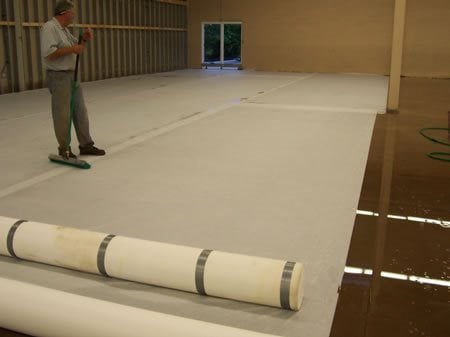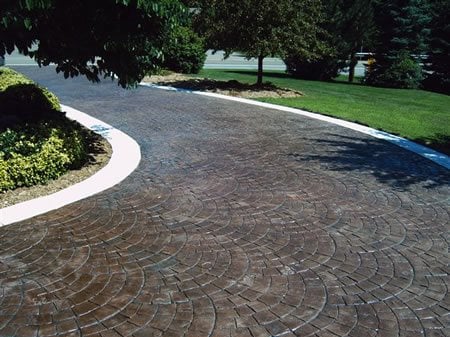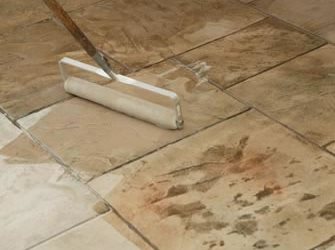- Concrete Curing Guide
- Curing Colored Concrete
- How Long Before You Can Drive on Concrete?
- How Long Before You Can Walk on Concrete?
- Curing Dos and Don'ts
- Cold Weather Curing
- Curing Products
- Related Information:
- Proper curing techniques for concrete driveways
- Concrete Calculator: How much concrete do you need?
- Product Newsletter: Sign up today to receive monthly updates
Methods for Curing Colored Concrete

Colored slabs can be wet cured without resulting in a mottled surface with special wicking curing blankets, like this HydraCure wet curing cover. PNA Construction Technologies.
Concrete with color, concrete that's stamped, even concrete that is going to be stained, still must be cured. Again, failing to cure is sure to lead to problems with the surfaces. We want our baby's skin to be perfect, don't we?
Why do We Cure Colored Concrete?One problem with colored concrete that plain gray doesn't worry about much is efflorescence (our baby has a skin disease!). Efflorescence is a powdery white material that forms on the surface of the concrete and that is caused by calcium hydroxide which is naturally in the concrete after it sets. As water moves out of the concrete it carriers with it some of this calcium hydroxide, which then reacts with carbon dioxide in the air to become calcium carbonate. On plain gray concrete, you really can't see efflorescence, and even if you can, typically no one worries about it. It doesn't affect the concrete's strength. On colored concrete, if you are careful about mix design, and get a cure & seal down as soon as possible, you can eliminate some of the danger of efflorescence.

Cure & seal should be applied in two coats, the first primarily for curing and the second for sealing. Vexcon Chemicals
Wet curing really is the best method and there are some good curing blankets out there now that work well on colored concrete surfaces. The problem has always been that it was impossible to get the blankets down smoothly so that curing was even. Small spots where the blanket is touching or where the surface dries out can lead to a mottled appearance. With the new single-use blankets that combine an absorbent material with plastic sheeting, though, such as PNA's HydraCure (www.pna-inc.com) or McTech Group's UltraCure (www.mctechgroup.com) wet curing of colored surfaces is now a good choice.
For slabs that are to be acid stained, wet curing is also the best approach. Any sort of curing agent (Find Cures & Curing Supplies) used would have to be completely removed so that the acid stain can penetrate. Use water and curing blankets in this situation.
The most common way to cure colored concrete, though, is to use liquid curing compounds. Specifically, what most people use is a cure & seal, a material that prevents enough moisture from leaving the concrete that it gets a good cure on the surface, but that can then also be used as a sealer, when applied as a second coat (or even a third coat). If you are using the same product for both applications, then you know the material is compatible.
One difficulty with stamped concrete can be when a colored release powder is used during stamping. The cure & seal can't be sprayed on until the release agent has been washed off—which could be several days later. In dry, windy conditions, that's probably too late to do much good. In his book Guide to Stamped Concrete, Bob Harris recommends covering the concrete with a layer of impervious building paper or plastic film—or both, first the paper then the plastic on top.
Why use cure & seal instead of a curing agent and a sealer? "Chemical curing compounds are temporary curing agents," said Vexcon's Cliff Platt. "If you use a curing compound and want to come back with a coating—an epoxy, a sealer, even a penetrating sealer--that curing compound can't be there. It has to go away. If it's an interior application it will never go away by itself--it would have to be removed after 28 days, a messy job. That's not the right product for that application.
"A cure & seal product is a dual function product," said Scott Thome, Director of Product Services, L.M. Scofield Company. "The 'cure' portion of the name means that it can be used as a liquid curing membrane for concrete. This material must be able to form a film on the surface of fresh concrete and hold in only a portion of the mix water to aid in the cement hydration process. The remaining unused water is allowed to evaporate through the membrane at a controlled rate. Without this process the design strength might not be developed. Some curing materials hold in too much water. That might be good for strength development but bad for color development. The 'seal' portion in the name means that it can also be used as a sealer. The sealer is applied when the concrete has had enough time to cure and release the majority of unused mix water. As a sealer it protects the concrete. Curing and sealing concrete are different processes and are performed at different times in the life of the concrete."
There is a wide variety of cure & seal products out there. Here are some tips for making a selection:
- There are two ASTM standards for liquid membrane-forming curing compounds, C 309 and C 1315. C 309 is the older, and less restrictive, standard that typically applies to curing agents used for highway work or bridge decks. For colored concrete, get a cure & seal that meets C 1315.
- Within C 1315, there are two Types of materials and three Classes of materials. You're probably going to want Type I, which is clear, as opposed to Type II, which has a white pigment.
- There are three Classes of ASTM C1315 materials, which defines how resistant the material is to ultraviolet light. Class A is non-yellowing; Class B has moderate yellowing, and Class C has no requirements on yellowing. For exterior decorative work, use Class A.
- C 1315 requires a minimum solid content of 25%; some products today have solids contents as high as 35%. In judging the percent solids of a cure & seal always check to make sure the solids are 100% acrylic. "In general, the higher the percentage of solids the better the product is as a sealer," said Nox-Crete's Mike Linn. "But percent solids can be deceiving. What a decorative contractor wants is all acrylic, Class A, higher solids content material."
- Higher percentage solids materials, though, can be more difficult to deal with. "You have to use the right sprayer," said Platt, "there are different sprayers for different products. You need the right tips size, the right pressure. As we push the technology of coatings, it becomes more important that there be a minimum level of knowledge or experience. In the old days, when there was only about 15% solids, it was easy to apply. Today with up to 35% solids the technology has gotten to where the contractor needs experience and training to do it right."
- Some manufacturers have color-matched cure & seal products. "When color uniformity over a large area is required, then use a color-matched product," said Thome. "It will provide a more consistent color from pour to pour. A clear cure & seal works well on projects that incorporate multiple colors. No masking is needed to separate the colors during application and because there are several colors on the project, a slight variation between pours will be less noticeable."
- The biggest separation in types of cure & seals is whether they are water- or solvent-based; most contractors prefer solvent-based. "Generally speaking, interior is the only place I will recommend a water-based sealer and only where there's an odor concern," said Platt. "The other reason for recommending a water-based material is the VOC requirements in certain states. Most companies can't meet those limits with a solvent-based product. Vexcon can, however, meet that limit with AC 1315 Super Gloss, a solvent-based material that just won the Most Innovative Product award at the World of Concrete."
- The other big advantage of a solvent-based material is drying time. Some will dry within a few hours, allowing the application of the sealer coat on the same day. Note that the first coat must be completely dry prior to applying the second coat.
 1300-CLEAR - Curing Compound
Wax based curing compound. Great for interior and exterior.
1300-CLEAR - Curing Compound
Wax based curing compound. Great for interior and exterior.
 Cures & Cure & Seals
Improved resistance to rain, the sun, freezing temperatures, stains, and more.
Cures & Cure & Seals
Improved resistance to rain, the sun, freezing temperatures, stains, and more.
 Water-based Curing Compound
VOC-Compliant. Easily applied with spray equipment.
Water-based Curing Compound
VOC-Compliant. Easily applied with spray equipment.





